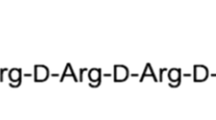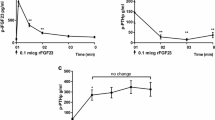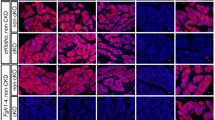Abstract
Background
In most cell types, influx of calcium (Ca2+) induces a growth or secretory response. The opposite occurs in parathyroid (PTH), cells where there is an inverse relationship between intracellular Ca2+ concentration and PTH secretion. We have examined the effects of calcium channel and metabolism modulators on insulin-like growth factors (IGFs) in a parathyroid cell culture model.
Methods
Cell cultures were prepared from 9 patients undergoing operation for hyperparathyroidism. Following adhesion, the cells were transferred to serum-free medium and dosed with IGF I, II ± ethyleneglycol-bis(β-aminoethyl)-N, N, N′,N′-tetraacetic acid (EGTA), nifedipine, nickel, 2-aminoethoxy-diphenylborate (2-APB), or dantrolene. Proliferation (96 hours) was assessed by measuring tritiated thymidine incorporation and PTH release (1 and 3 hours) assayed by IRMA.
Results
Both IGF I and II increased DNA synthesis to 162.8% ± 10.6% (SEM) and 131.1% ± 7.7%, respectively (P < 0.05). EGTA at 0.2 mmol (ionized Ca2+ 0.2mmol) did not affect the response to both IGFs. EGTA at 2 mmol (ionized Ca2+ 0 mmol) reduced the DNA synthesis of IGF I and II to 29% and 26%, respectively (P < 0.05). Nifedipine and nickel (nonspecific Ca2+ channel blocker) were equally potent in negating the mitogenic effects of both IGFs. 2-APB (IP3R blocker) reduced the basal DNA synthesis to 51.3% ± 8.4% but had no effect on either IGF. Dantrolene (ryanodine receptor blocker) negated IGF II induced mitogenisis (74.2% ± 6.7%) and partially inhibited IGF I mitogenesis (123% ± 6%) (P < 0.05). The rate of PTH secretion was greater after IGF II stimulation than after IGF I stimulation.
Conclusions
IGFs I and II induce mitogenesis by different calcium signaling pathways. These data suggest that parathyroid cells may utilize different calcium signaling pathways to distinguish growth factors and serum calcium changes.








Similar content being viewed by others
References
Berridge MJ, Lipp P, Bootman MD. The versatility, universality of calcium signalling. Nat Rev Mol Cell Biol 2000;1:11–21
Flynn ER, Bradley KN, Muir TC, et al. Functionally separate intracellular Ca2+ stores in smooth muscle. J Biol Chem 2001;276:36411–36418
Kremer R, Bolivar I, Goltzman D, et al. Influence of calcium and 1,25–dihydroxycholecalciferol on proliferation and proto-oncogene expression in primary cultures of bovine parathyroid cells. Endocrinology 1989;125:935–941
Kojima I, Matsunaga H, Kurokawa K, et al. Calcium influx: an intracellular message of the mitogenic action of insulin-like growth factor-I. J Biol Chem 1988;263:16561–16567
Furuya Y, Lundmo P, Short AD, et al. The role of calcium, pH, and cell proliferation in the programmed (apoptotic) death of androgen-independent prostatic cancer cells induced by thapsigargin. Cancer Res 1994;54:6167–6175
Cohen J, Gierlowski TC,Schneider AB. A prospective study of hyperparathyroidism in individuals exposed to radiation in childhood. JAMA 1990;264:581–584
Pocotte SL, Ehrenstein G, Fitzpatrick LA. Role of calcium channels in parathyroid hormone secretion. Bone 1995;16:365S–372S
Brown AJ, Ritter C, Slatopolsky E, et al. 1Alpha,25-dihydroxy-3-epi-vitamin D3, a natural metabolite of 1alpha,25-dihydroxyvitamin D3, is a potent suppressor of parathyroid hormone secretion. J Cell Biochem 1999;73:106–113
Brown EM, Hebert SC. Calcium-receptor-regulated parathyroid and renal function. Bone 1997;20:303–309
Malaisse WJ. Calcium entry and activation of endocrine cells. Ann N Y Acad Sci 1988;522:284–295
Leof EB. Growth factor receptor signalling: location, location, location. Trends Cell Biol 2000;10:343–348
Berridge MJ. Inositol trisphosphate and calcium signalling. Nature 1993;361:315–325
Berridge MJ, Irvine RF. Inositol trisphosphate, a novel second messenger in cellular signal transduction. Nature 1984;312:315–321
Nahorski SR. Inositol polyphosphates and neuronal calcium homeostasis. Trends Neurosci 1988;11:444–448
Mikoshiba K,Hattori M. IP3 receptor-operated calcium entry. Sci STKE 2000;2000:PE1
Kanzaki M, Nie L, Shibata H, et al. Activation of a calcium-permeable cation channel CD20 expressed in Balb/c 3T3 cells by insulin-like growth factor-I. J Biol Chem 1997;272:4964–4969
Kanzaki M, Zhang YQ, Mashima H, et al. Translocation of a calcium-permeable cation channel induced by insulin-like growth factor-I. Nat Cell Biol 1999;1:165–170
Kojima I, Mogami H,Ogata E. Oscillation of cytoplasmic free calcium concentration induced by insulin-like growth factor I. Am J Physiol 1992;262:E307–E311
Kojima I, Nishimoto I, Iiri T, et al. Evidence that type II insulin-like growth factor receptor is coupled to calcium gating system. Biochem Biophys Res Commun 1988;154:9–19
Wang ZM, Messi ML, Renganathan M, et al. Insulin-like growth factor-1 enhances rat skeletal muscle charge movement and L-type Ca2+ channel gene expression. J Physiol 1999;516 ( Pt 2):331–341
Poiraudeau S, Lieberherr M, Kergosie N, et al. Different mechanisms are involved in intracellular calcium increase by insulin-like growth factors 1 and 2 in articular chondrocytes: voltage-gated calcium channels, and/or phospholipase C coupled to a pertussis-sensitive G-protein. J Cell Biochem 1997;64:414–422
Nishimoto I, Murayama Y, Katada T, et al. Possible direct linkage of insulin-like growth factor-II receptor with guanine nucleotide-binding proteins. J Biol Chem 1989;264:14029–14038
Takasu N, Takasu M, Komiya I, et al. Insulin-like growth factor I stimulates inositol phosphate accumulation, a rise in cytoplasmic free calcium, and proliferation in cultured porcine thyroid cells. J Biol Chem 1989;264:18485–18488
Solem ML, Thomas AP. Modulation of cardiac Ca2+ channels by IGF1. Biochem Biophys Res Commun 1998;252:151–155
Tanaka R, Tsushima T, Murakami H, et al. Insulin-like growth factor I receptors and insulin-like growth factor-binding proteins in human parathyroid tumors. World J Surg 1994;18:635–641; discussion 641–632
Sadler GP, Jones DL, Woodhead JS, et al. Effect of growth factors on growth of bovine parathyroid cells in serum-free medium. World J Surg 1996;20:822–828; discussion 828–829
Wong C, Lai T, Hilly JM, et al. Selective estrogen receptor modulators inhibit the effects of insulin-like growth factors in hyperparathyroidism. Surgery 2002;132:998–1006; discussion 1006–1007
Corbetta S, Mantovani G, Lania A, et al. Calcium-sensing receptor expression and signalling in human parathyroid adenomas and primary hyperplasia. Clin Endocrinol (Oxf) 2000;52:339–348
Yano S, Sugimoto T, Tsukamoto T, et al. Association of decreased calcium-sensing receptor expression with proliferation of parathyroid cells in secondary hyperparathyroidism. Kidney Int 2000;58:1980–1986
Brownlee C. Cellular calcium imaging: so, what’s new? Trends Cell Biol 2000;10:451–457
Campbell KP, Leung AT, Sharp AH. The biochemistry and molecular biology of the dihydropyridine-sensitive calcium channel. Trends Neurosci 1988;11:425–430
Tsien RW, Lipscombe D, Madison DV, et al. Multiple types of neuronal calcium channels and their selective modulation. Trends Neurosci 1988;11:431–438
Yellen G. Calcium channels. Structure and selectivity. Nature 1993;366:109–110
Gregory RB, Rychkov G, Barritt GJ. Evidence that 2-aminoethyl diphenylborate is a novel inhibitor of store-operated Ca2+ channels in liver cells, and acts through a mechanism which does not involve inositol trisphosphate receptors. Biochem J 2001;354:285–290
Hotchkiss RS, Karl IE. Dantrolene ameliorates the metabolic hallmarks of sepsis in rats and improves survival in a mouse model of endotoxemia. Proc Natl Acad Sci USA 1994;91:3039–3043
Furukawa T, Yamakawa T, Midera T, et al. Selectivities of dihydropyridine derivatives in blocking Ca(2+) channel subtypes expressed in Xenopus oocytes. J Pharmacol Exp Ther 1999;291:464–473
Lee JH, Gomora JC, Cribbs LL, et al. Nickel block of three cloned T-type calcium channels: low concentrations selectively block alpha1H. Biophys J 1999;77:3034–3042
Zamponi GW, Bourinet E, Snutch TP. Nickel block of a family of neuronal calcium channels: subtype- and subunit-dependent action at multiple sites. J Membr Biol 1996;151:77–90
Kifor O, MacLeod RJ, Diaz R, et al. Regulation of MAP kinase by calcium-sensing receptor in bovine parathyroid and CaR-transfected HEK293 cells. Am J Physiol Renal Physiol 2001;280:F291–F302
Brown EM. Physiology and pathophysiology of the extracellular calcium-sensing receptor. Am J Med 1999;106:238–253
Shoback DM, Thatcher J, Leombruno R, et al. Relationship between parathyroid hormone secretion and cytosolic calcium concentration in dispersed bovine parathyroid cells. Proc Natl Acad Sci USA 1984;81:3113–3117
Shoback D, Chen TH, Pratt S, et al. Thapsigargin stimulates intracellular calcium mobilization and inhibits parathyroid hormone release. J Bone Miner Res 1995;10:743–750
Bean BP. Classes of calcium channels in vertebrate cells. Annu Rev Physiol 1989;51:367–384
Hess P. Calcium channels in vertebrate cells. Annu Rev Neurosci 1990;13:337–356
Chang W, Pratt SA, Chen TH, et al. Parathyroid cells express dihydropyridine-sensitive cation currents and L-type calcium channel subunits. Am J Physiol Endocrinol Metab 2001;281:E180–E189
Fitzpatrick LA, Yasumoto T, Aurbach GD. Inhibition of parathyroid hormone release by maitotoxin, a calcium channel activator. Endocrinology 1989;124:97–103
Hobai IA, Hancox JC, Levi AJ. Inhibition by nickel of the L-type Ca channel in guinea pig ventricular myocytes and effect of internal cAMP. Am J Physiol Heart Circ Physiol 2000;279:H692–H701
Jones KT, Sharpe GR. Ni2+ blocks the Ca2+ influx in human keratinocytes following a rise in extracellular Ca2+. Exp Cell Res 1994;212:409–413
Lacinova L, Klugbauer N, Hofmann F. Regulation of the calcium channel alpha(1G) subunit by divalent cations and organic blockers. Neuropharmacology 2000;39:1254–1266
Silva AM, Rosario LM, Santos RM. Background Ca2+ influx mediated by a dihydropyridine- and voltage-insensitive channel in pancreatic beta-cells. Modulation by Ni2+, diphenylamine-2-carboxylate, and glucose metabolism. J Biol Chem 1994;269:17095–17103
Chang W, Chen TH, Gardner P, et al. Regulation of Ca(2+)-conducting currents in parathyroid cells by extracellular Ca(2+) and channel blockers. Am J Physiol 1995;269:E864–E877
Larsson R, Akerstrom G, Gylfe E, et al. Paradoxical effects of K+ and D-600 on parathyroid hormone secretion and cytoplasmic Ca2+ in normal bovine and pathological human parathyroid cells. Biochim Biophys Acta 1985;847:263–269
Lee HC. Multiple calcium stores: separate but interacting. Sci STKE. 2000;2000:PE1
Skryma R, Mariot P, Bourhis XL, et al. Store depletion and store-operated Ca2+ current in human prostate cancer LNCaP cells: involvement in apoptosis. J Physiol 2000;527 Pt 1:71–83
Charlesworth A, Rozengurt E. Thapsigargin and di-tert-butylhydroquinone induce synergistic stimulation of DNA synthesis with phorbol ester and bombesin in Swiss 3T3 cells. J Biol Chem 1994;269:32528–32535
Egea J, Espinet C, Comella JX. Calcium influx activates extracellular-regulated kinase/mitogen-activated protein kinase pathway through a calmodulin-sensitive mechanism in PC12 cells. J Biol Chem 1999;274:75–85
Zhu DM, Tekle E, Huang CY, et al. Inositol tetrakisphosphate as a frequency regulator in calcium oscillations in HeLa cells. J Biol Chem 2000;275:6063–6066
Pocotte SL, Ehrenstein G, Fitzpatrick LA. Regulation of parathyroid hormone secretion. Endocr. Rev. 1991;12:291–301
Brown EM, Pollak M, Hebert SC. Sensing of extracellular Ca2+ by parathyroid and kidney cells: cloning and characterization of an extracellular Ca(2+)-sensing receptor. Am J Kidney Dis 1995;25:506–513
Chattopadhyay N, Mithal A, Brown EM. The calcium-sensing receptor: a window into the physiology and pathophysiology of mineral ion metabolism. Endocrinol Rev 1996;17:289–307
Ho C, Conner DA, Pollak MR, et al. A mouse model of human familial hypocalciuric hypercalcemia and neonatal severe hyperparathyroidism. Nat Genet 1995;11:389–394
Fill M, Coronado R. Ryanodine receptor channel of sarcoplasmic reticulum. Trends Neurosci 1988;11:453–457
Meldolesi J, Volpe P, Pozzan T. The intracellular distribution of calcium. Trends Neurosci 1988;11:449–452
Cohen Y, Rahamimov R, Naveh-Many T, et al. Where is the “inverting factor” in hormone secretion from parathyroid cells? Am J Physiol 1997;273:E631–E637
Chang JM, Hwang SJ, Tsai JC, et al. In vivo effect of endothelin-1 on plasma calcium and parathyroid hormone concentrations. J Endocrinol 2000;165:179–184
Tanini A, Failli P, Maggi M, et al. Effects of endothelin-1 on bovine parathyroid cells. Biochem Biophys Res Commun 1993;193:59–66
Larsson C. Dissecting the genetics of hyperparathyroidism—new clues from an old friend. J Clin Endocrinol Metab 2000;85:1752–1754
Muff R, Nemeth EF, Haller-Brem S, et al. Regulation of hormone secretion and cytosolic Ca2+ by extracellular Ca2+ in parathyroid cells and C-cells: role of voltage-sensitive Ca2+ channels. Arch Biochem Biophys 1988;265:128–135
Frodin M, Sekine N, Roche E, et al. Glucose, other secretagogues, and nerve growth factor stimulate mitogen-activated protein kinase in the insulin-secreting beta-cell line, INS-1. J Biol Chem. 1995;270:7882–7889
Hughes SJ, Chalk JG, Ashcroft SJ. Effect of secretagogues on cytosolic free Ca2+ and insulin release at different extracellular Ca2+ concentrations in the hamster clonal beta-cell line HIT-T15. Mol Cell Endocrinol 1989;65:35–41
Jimenez N, Hernandez-Cruz A. Modifications of intracellular Ca2+ signalling during nerve growth factor-induced neuronal differentiation of rat adrenal chromaffin cells. Eur J Neurosci 2001;13:1487–1500
Meyer zu Heringdorf D, Lass H, Kuchar I, et al. Role of sphingosine kinase in Ca(2+) signalling by epidermal growth factor receptor. FEBS Lett 1999;461:217–222
Legrand G, Humez S, Slomianny C, et al. Ca2+ pools and cell growth. Evidence for sarcoendoplasmic Ca2+-ATPases 2B involvement in human prostate cancer cell growth control. J Biol Chem 2001;276:47608–47614
Garrouste FL, Remacle-Bonnet MM, Lehmann MM, et al. Up-regulation of insulin/insulin-like growth factor-I hybrid receptors during differentiation of HT29-D4 human colonic carcinoma cells. Endocrinology 1997;138:2021–2032
Frasca F, Pandini G, Scalia P, et al. Insulin receptor isoform A, a newly recognized, high-affinity insulin-like growth factor II receptor in fetal and cancer cells. Mol Cell Biol 1999;19:3278–3288
Louvi A, Accili D, Efstratiadis A. Growth-promoting interaction of IGF-II with the insulin receptor during mouse embryonic development. Dev Biol 1997;189:33–48
Korc M, Williams JA, Goldfine ID. Stimulation of the glucose transport system in isolated mouse pancreatic acini by cholecystokinin and analogues. J Biol Chem 1979;254:7624–7629
Hansen BF, Danielsen GM, Drejer K, et al. Sustained signalling from the insulin receptor after stimulation with insulin analogues exhibiting increased mitogenic potency. Biochem J 1996;315 (Pt 1):271–279
Shymko RM, Dumont E, De Meyts P, et al. Timing-dependence of insulin-receptor mitogenic versus metabolic signalling: a plausible model based on coincidence of hormone and effector binding. Biochem J 1999;339 ( Pt 3):675–683
Giguere V, Tremblay A,Tremblay GB. Estrogen receptor beta: re-evaluation of estrogen and antiestrogen signaling. Steroids 1998;63:335–339
Author information
Authors and Affiliations
Corresponding author
Additional information
An erratum to this article is available at http://dx.doi.org/10.1007/s00268-006-0264-5.
Rights and permissions
About this article
Cite this article
Wong, C.K.M., Lai, T., Holly, J.M.P. et al. Insulin-like Growth Factors (IGF) I and II Utilize Different Calcium Signaling Pathways in a Primary Human Parathyroid Cell Culture Model. World J. Surg. 30, 333–345 (2006). https://doi.org/10.1007/s00268-005-0339-8
Published:
Issue Date:
DOI: https://doi.org/10.1007/s00268-005-0339-8




